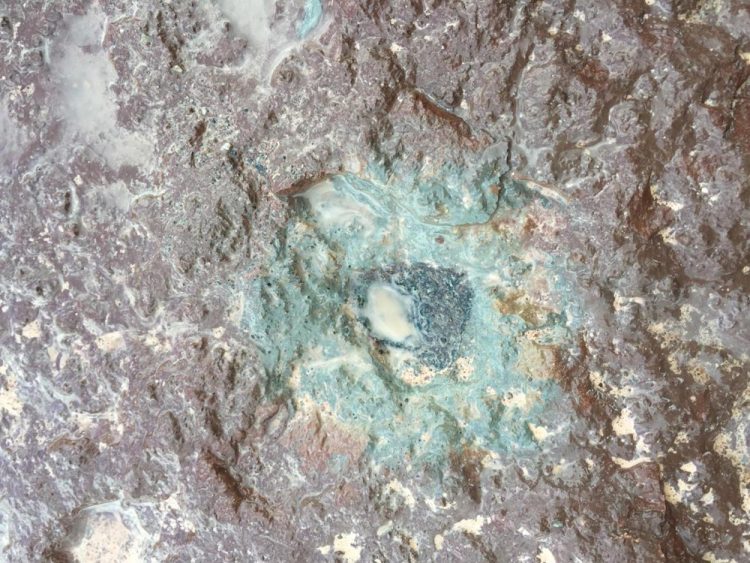New type of meteorite linked to ancient asteroid collision

A meteorite discovered in a Swedish quarry is unique and distinct from other meteorites. It appears to be a relic of a massive collision in the asteroid belt 470 million years ago that send debris raining to Earth during the Ordovician Period. In this image, the black 'fossil' meteorite is preserved in slate from the quarry. Credit: Qing-zhu Yin, UC Davis
“In our entire civilization, we have collected over 50,000 meteorites, and no one has seen anything like this one before,” said study co-author Qing-zhu Yin, professor of geochemistry and planetary sciences at the University of California, Davis. “Discovering a new type of meteorite is very, very exciting.”
The new meteorite, called Ost 65, appears to be from the missing partner in a massive asteroid collision 470 million years ago. The collision sent debris falling to Earth over about a million years and may have influenced a great diversification of life in the Ordovician Period. One of the objects involved in this collision is well-known: It was the source of L-chondrites, still the most common type of meteorite. But the identity of the object that hit it has been a mystery.
Ost 65 was discovered in Sweden's Thorsberg quarry, source of more than 100 fossil meteorites. Measuring just under 4 inches wide, it looks like a gray cow patty plopped into a pristine layer of fossil-rich pink limestone. The Ost 65 rock is called a fossil meteorite because the original rock is almost completely altered except for a few hardy minerals — spinels and chromite. Analyses of chromium and oxygen isotopes in the surviving minerals allowed the researchers to conclude the Ost 65 meteorite is chemically distinct from all known meteorite types.
By measuring how long Ost 65 was exposed to cosmic rays, the team established that it traveled in space for about a million years before it fell to Earth 470 million years ago. This timeline matches up with L-chondrite meteorites found in the quarry, leading the study authors to suggest the rock is a fragment of the other object from the Ordovician collision. The original object may have been destroyed during the collision, but it's also possible that the remains are still out in space.
Meteorites may have influenced evolution
Researchers think that about 100 times as many meteorites slammed into Earth during the Ordovician compared with today, thanks to the massive collision in the asteroid belt. This rain of meteorites may have opened new environmental niches for organisms, thus boosting both the diversity and complexity of life on Earth.
“I think this shows the interconnectedness of the entire solar system in space and time, that a random collision 470 million years ago in the asteroid belt could dictate the evolutionary path of species here on Earth,” Yin said.
The study was led by Birger Schmitz, of Lund University in Sweden. Yin, of UC Davis, together with his postdoctoral fellow Matthew Sanborn, made the very precise measurement of chromium in tiny mineral grains within the meteorite. Researchers from the University of Hawaii at Manoa analyzed its oxygen isotopes.
The new findings strengthen suspicions that more recent meteorite falls on Earth do not represent the full range of rocks drifting through the solar system. Yin said there is potential to better understand the history of our solar system by collecting meteorite fragments preserved in Earth's ancient rocks. “If we can go back even further in time, we may eventually be able to find some of the true building blocks of Earth,” Yin said.
###
The research was funded by NASA, the UC Office of the President and a European Research Council Advanced Grant.
Media Contact
All latest news from the category: Earth Sciences
Earth Sciences (also referred to as Geosciences), which deals with basic issues surrounding our planet, plays a vital role in the area of energy and raw materials supply.
Earth Sciences comprises subjects such as geology, geography, geological informatics, paleontology, mineralogy, petrography, crystallography, geophysics, geodesy, glaciology, cartography, photogrammetry, meteorology and seismology, early-warning systems, earthquake research and polar research.
Newest articles

Superradiant atoms could push the boundaries of how precisely time can be measured
Superradiant atoms can help us measure time more precisely than ever. In a new study, researchers from the University of Copenhagen present a new method for measuring the time interval,…

Ion thermoelectric conversion devices for near room temperature
The electrode sheet of the thermoelectric device consists of ionic hydrogel, which is sandwiched between the electrodes to form, and the Prussian blue on the electrode undergoes a redox reaction…

Zap Energy achieves 37-million-degree temperatures in a compact device
New publication reports record electron temperatures for a small-scale, sheared-flow-stabilized Z-pinch fusion device. In the nine decades since humans first produced fusion reactions, only a few fusion technologies have demonstrated…





















